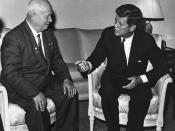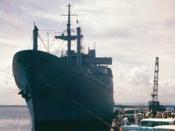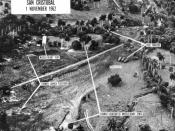The Cuban Missile crisis was perhaps the closest the world has gone to the point of all out nuclear war, and for 13 days in October the world was watching a dangerous game of ideological brinkmanship. The intensity of the situation was probably best described by Soviet General and Army Chief of Operations, Anatoly Gribkov as, "nuclear catastrophe was hanging by a thread ... and we weren't counting days or hours, but minutes."
The trigger for the Cuban Missile Crisis occurred when reconnaissance photos taken by the United States of Cuba showed a significant Soviet build-up of strategic missiles. Cuba was 150 kilometres from the American mainland, and this was considered to be a considerable threat on behalf of the Soviets.
The Soviets were amassing these weapons in Cuba because they knew the Soviet Union was desperately behind the United States in the arms race. Soviet missiles were only powerful enough to be launched against Europe but U.S.
missiles were capable of striking the entire Soviet Union. In late April 1962, Soviet Premier Nikita Khrushchev conceived the idea of placing intermediate-range missiles in Cuba. A deployment in Cuba would double the Soviet strategic arsenal and provide a real deterrent to a potential U.S. attack against the Soviet Union. Castro agreed to this plan, only because he was searching for a barrier to stop a US invasion.
When Kennedy ordered a quarantine put on Cuba and a naval blockade to be implemented, he announced the discovery of the missiles to the public. He also proclaimed that any nuclear missile launched from Cuba would be regarded as an attack on the United States by the Soviet Union and demanded that the Soviets remove all of their offensive weapons from Cuba.
During the public phase of the Crisis, tensions began to build on...


